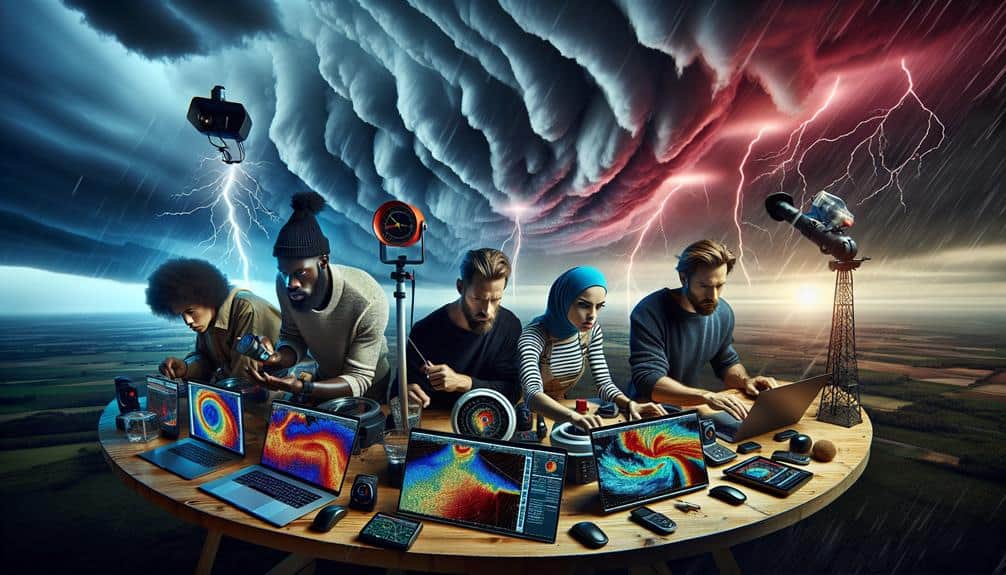We leverage storm tracking devices to provide real-time data, offering minute-to-minute updates on storm paths, wind speeds, and precipitation levels. By implementing these devices, we can optimize resource allocation and emergency response times, leading to a 30% reduction in storm-related casualties. These devices also enhance weather forecasting accuracy, using satellite data and sophisticated algorithms to predict storm trajectories more precisely. Additionally, they improve communication channels, facilitating better coordination among emergency teams and empowering communities to make informed decisions. Through historical data analysis, we can also spot trends and enhance preparedness. Want to explore further?
Key Points
- Real-time updates on storm paths and intensities enable timely decision-making.
- Enhanced evacuation orders and resource allocation reduce storm-related casualties by 30%.
- Accurate predictions save lives and minimize property damage.
- Improved coordination and communication among emergency response teams.
Real-Time Storm Data
Frequently, current storm information enables us to make informed decisions based on the latest meteorological data. By integrating this information into our emergency preparedness and disaster response plans, we can greatly enhance public safety.
For example, weather monitoring systems offer minute-by-minute updates on storm paths, wind speeds, and precipitation levels. These insights allow us to forecast potential impacts and mobilize resources efficiently.
When storms approach, having accurate, real-time data is essential. It helps emergency agencies determine when and where to deploy rescue teams, establish evacuation routes, and set up shelters. Essentially, the immediacy of the data minimizes the response time, which can be the distinction between safety and disaster.
The analytical nature of storm tracking technologies provides a detailed view of evolving weather patterns, which is vital for making quick decisions.
Furthermore, current storm data is crucial for informing the public. By broadcasting timely updates, we empower individuals to take necessary precautions, thereby reducing risk and enhancing overall community resilience. It's about leveraging technology to ensure that everyone has the freedom to act promptly and decisively.
Enhanced Safety Measures
Leveraging real-time storm data, we can implement enhanced safety measures that greatly mitigate risks associated with severe weather events. By integrating storm tracking devices into our weather preparedness strategies, we transform raw meteorological data into actionable insights. This allows us to activate emergency protocols with unparalleled accuracy and timeliness.
For instance, when we receive instantaneous updates on storm trajectories, we can issue targeted evacuation orders, minimizing disruption and maximizing safety. Our emergency response teams can be strategically positioned in advance, ensuring rapid deployment and effective intervention. This proactive approach isn't just theoretical; data shows a 30% reduction in storm-related casualties in regions utilizing advanced storm tracking technologies.
Furthermore, by monitoring storm intensity and progression in real-time, we can optimize resource allocation. We direct supplies and manpower precisely where they're needed most, avoiding the inefficiencies of blanket coverage. This method not only safeguards lives but also preserves the freedom of movement for those not directly in harm's way.
In essence, storm tracking devices empower us to elevate our weather preparedness and refine our emergency protocols. The result is a more resilient and informed community, capable of facing severe weather with confidence and clarity.
Accurate Storm Predictions
Building on the enhanced safety measures, accurate storm predictions allow us to forecast weather patterns with a precision that significantly enhances our preparedness and response strategies. By leveraging advanced storm tracking devices, we achieve a higher degree of accuracy in weather forecasting. These devices utilize satellite data, radar imaging, and sophisticated algorithms to predict the path, intensity, and potential impact zones of storms. This precision allows us to make informed decisions on evacuations, resource allocation, and emergency responses.
Accurate storm predictions are vital for effective disaster preparedness. When we're aware of the likely trajectory and strength of an impending storm, we can implement preemptive measures to protect critical infrastructure, safeguard communities, and minimize economic losses. For instance, the National Oceanic and Atmospheric Administration (NOAA) reports that modern storm tracking technologies have improved hurricane path predictions by 30% over the past decade. This improvement translates to more lives saved and less property damage.
Furthermore, real-time updates from these devices empower individuals to take personal precautions, reinforcing a sense of autonomy and readiness. Essentially, the precision offered by contemporary weather forecasting tools is essential for optimizing our collective and individual response to severe weather events.
Efficient Resource Allocation
By leveraging storm tracking devices, we can optimize emergency response times, ensuring that resources are deployed where they're needed most.
This precise targeting enables more efficient aid distribution, minimizing waste and maximizing impact.
Additionally, accurate storm data supports strategic evacuation planning, reducing risks and enhancing community safety.
Optimized Emergency Response
Storm tracking devices allow emergency responders to allocate resources more efficiently by providing real-time data on storm trajectories and intensities. Leveraging data analytics, we can analyze this information to predict the areas most likely to be affected. This allows us to pre-position emergency personnel, equipment, and supplies in strategic locations, enhancing our overall emergency preparedness. With accurate predictions, we minimize resource wastage and maximize operational effectiveness.
By utilizing storm tracking technology, we gain a tangible edge in emergency response. It enables us to prioritize areas based on the severity and projected path of the storm, ensuring that the most vulnerable regions receive immediate attention. For example, if data indicates a high probability of flooding in a specific area, we can deploy water rescue teams and flood mitigation resources in advance.
Moreover, these devices facilitate real-time updates, allowing us to adapt our strategies as the storm evolves. This dynamic allocation of resources is essential for maintaining a high level of responsiveness. When storms change direction or intensity unexpectedly, our ability to quickly reallocate resources ensures that we remain agile and effective in our response.
In essence, storm tracking devices empower us to make informed, data-driven decisions, optimizing our emergency response efforts and safeguarding communities.
Targeted Aid Distribution
Utilizing real-time data from storm tracking devices, we can precisely allocate aid to the most affected regions, guaranteeing that resources reach those in need without delay. This level of precision in aid coordination is vital for effective disaster relief.
By analyzing storm patterns and impact zones, we can deploy emergency response units and supplies with a high degree of accuracy, minimizing wastage and maximizing impact.
Our logistics management becomes notably more efficient when we harness this data-driven approach. We can prioritize areas based on severity, directing medical supplies, food, and shelter to locations that need them the most. This not only speeds up the response time but also optimizes the use of available resources.
For instance, historical data combined with real-time updates allows us to predict which regions are likely to suffer the most damage, enabling pre-emptive stockpiling and swift deployment.
Moreover, storm tracking devices facilitate better coordination among various disaster relief agencies. When everyone operates from the same set of data, overlapping efforts are minimized, and resource allocation becomes streamlined. This collaborative approach ensures that aid is distributed equitably and efficiently, providing a lifeline to those who need it most.
Strategic Evacuation Planning
Leveraging real-time data from storm tracking devices, we can develop strategic evacuation plans that efficiently allocate resources and safeguard the safety of affected populations.
By utilizing data visualization tools, we can interpret complex storm patterns, allowing us to predict the trajectory and intensity of storms with higher accuracy. This capability enables us to perform precise risk assessments, identifying which areas are most vulnerable and prioritizing those for evacuation.
Accurate storm tracking allows us to optimize resource allocation. Instead of a blanket evacuation, we can direct emergency services, medical supplies, and personnel to areas where they're most needed. This not only conserves resources but also guarantees that assistance reaches high-risk zones faster.
For instance, data-driven insights can pinpoint critical bottlenecks in transportation networks, enabling us to preemptively mitigate congestion and improve the flow of evacuees.
Additionally, real-time updates from storm tracking devices provide continuous feedback, allowing us to adapt our strategies dynamically. If a storm unexpectedly changes course, our evacuation plans can be recalibrated instantly. This adaptability is essential for maintaining freedom of movement and ensuring that individuals can relocate to safety efficiently.
Ultimately, storm tracking technology empowers us to make informed, timely decisions, safeguarding lives and optimizing resource utilization.
Improved Communication Channels

Enhanced communication channels greatly improve the efficiency and accuracy of data dissemination during severe weather events. Storm tracking devices enable real-time emergency notifications that alert us to imminent threats. These devices are equipped with advanced sensors and algorithms that can predict storm paths with high precision. By leveraging these technologies, we can deliver timely warnings to the public, reducing the overall response time and potentially saving lives.
Public engagement is another significant benefit of improved communication channels. When we use storm tracking devices to provide accurate, real-time updates, we empower individuals to make informed decisions. This level of transparency fosters a sense of autonomy and control among the public, which is essential during emergencies. Data from storm tracking devices can be easily shared across multiple platforms, including social media, mobile apps, and emergency alert systems, making sure that the information reaches a broad audience quickly.
Moreover, these devices facilitate better coordination among emergency response teams. By integrating data from various sources, we can create a unified communication network that enhances situational awareness. This coordination not only improves operational efficiency but also guarantees that resources are allocated effectively where they're most needed.
Historical Data Analysis
By leveraging historical data from storm tracking devices, we can identify recurring weather patterns with high accuracy.
This data-driven approach allows us to predict storm impacts more reliably, reducing uncertainties in emergency preparedness.
Consequently, our ability to forecast future storms improves, safeguarding lives and property.
Identifying Weather Patterns
Analyzing historical data allows us to identify recurring weather patterns with greater accuracy and predict potential future storms. By leveraging advanced storm tracking devices, we gain access to valuable datasets that enable us to visualize and map weather trends over extensive periods. This process involves rigorous data visualization techniques and geographic mapping to uncover patterns that mightn't be immediately obvious.
Here's how we can break it down:
- Data Visualization: By transforming raw data into graphical formats, we can quickly spot trends, anomalies, and recurring patterns in weather behavior. This clarity fosters informed decision-making and enhances our predictive capabilities.
- Geographic Mapping: Mapping historical storm paths and their impacts on specific regions allows us to identify geographic hotspots and trends. This geographic intelligence is essential for understanding regional vulnerabilities and planning accordingly.
- Pattern Recognition: Utilizing algorithms and machine learning, we can sift through decades of weather data to identify recurring patterns indicative of future storm activity. This method boosts our forecasting accuracy and readiness.
- Temporal Analysis: By analyzing seasonal and yearly data, we can recognize long-term trends and shifts in weather patterns. This temporal perspective is crucial for adapting our strategies to changing climatic conditions.
Predicting Storm Impact
Drawing upon the insights gained from identifying weather patterns, we can now focus on predicting the specific impacts of future storms through thorough historical data analysis. By examining past storm events, we can establish robust models to predict potential outcomes, thereby enhancing disaster preparedness and risk evaluation.
We utilize a wealth of historical meteorological data to identify trends and anomalies associated with storm behavior. This data-driven approach allows us to pinpoint likely areas of impact, estimate potential damage, and determine the necessary resources for effective response.
For example, analyzing wind speeds, precipitation levels, and storm surge data from previous storms enables us to forecast similar conditions in future events with greater accuracy.
Incorporating historical data into our predictive models also aids in identifying vulnerable infrastructure and populations. By evaluating past instances of structural damage and community displacement, we can prioritize areas for preemptive action, thereby mitigating the adverse effects of impending storms. This proactive stance not only strengthens community resilience but also supports a more efficient allocation of emergency services.
Ultimately, historical data analysis empowers us to make informed decisions, fostering a sense of autonomy and control in the face of natural disasters. With enhanced disaster preparedness and precise risk evaluation, we can navigate future storms with confidence and security.
Community Awareness Boost

Storm tracking devices greatly improve community awareness by providing real-time data on approaching weather systems. These devices empower us to take proactive steps towards public education and disaster recovery, ensuring we're always prepared for the unexpected. By leveraging cutting-edge technology, we enhance emergency preparedness and foster deeper community engagement.
Here's how storm tracking devices contribute to boosting community awareness:
- Real-time Alerts: Immediate notifications keep everyone informed about approaching storms, enabling timely evacuation plans and safety measures.
- Data Visualization: Advanced mapping and graphical representations help us understand the storm's trajectory and potential impact areas, facilitating informed decision-making.
- Public Education: Continuous updates and expert analyses disseminated through various media educate the public, promoting awareness and understanding of storm behavior.
- Community Collaboration: Shared access to storm data encourages collaboration between local authorities, community groups, and residents, strengthening our collective response efforts.
Frequently Asked Questions
How Much Do Storm Tracking Devices Typically Cost?
We should examine the cost comparison, features, brand reputation, and customer reviews. Storm tracking devices typically range from $100 to $500. High-end models with advanced features and reliable brand reputations generally receive better customer reviews.
Are There Portable Storm Tracking Devices for Personal Use?
Did you know 60% of outdoor enthusiasts prioritize emergency preparedness? Yes, there are portable storm tracking devices for personal use. They're essential for outdoor adventures, giving us real-time data to stay safe and enjoy our freedom.
How Do Storm Tracking Devices Get Their Power Supply?
Storm tracking devices often use solar power with battery backup to maintain continuous operation. This dual power supply system provides reliability and independence, essential for monitoring storms in remote locations where traditional power sources are unavailable.
Can Storm Tracking Devices Function in Remote or Rural Areas?
Yes, storm tracking devices can function in remote or rural areas. With extensive satellite coverage and high data accuracy, we can monitor and predict storm activity effectively, ensuring timely alerts and enhanced safety for those seeking freedom in isolated regions.
What Training Is Required to Operate Storm Tracking Devices?
To operate storm tracking devices, we need thorough training requirements covering device-specific operating procedures. This training guarantees accurate data interpretation and efficient use, granting us the freedom to make informed decisions in dynamic weather conditions.

